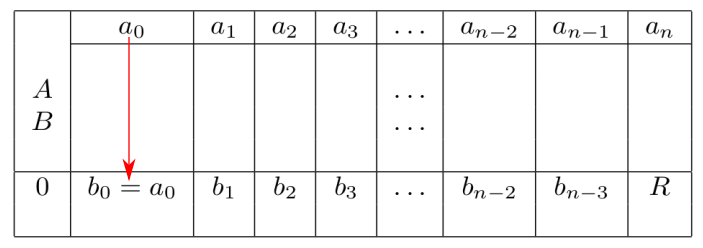A detailed procedure for the synthetic division when the divisor is a second-degree polynomial
You most probably have learned the synthetic division method for the polynomial when divided by $x-a$. But, what if the divisor is a second-degree polynomial? Now, the method you were trained will not work.
In this post, I will try to explain a bit more detail about the method which will work for our proposed problem. Let me start by defining a general expression for the polynomial as $P(x) = a_{0}x^{n} + a_{1}x^{n-1} + a_{2}x^{n-2} + \ldots + a_{n-1}x + a_{n}$. Lets say, our divisor will be $x^{2} + Kx + L$ and reminder be $R$. I must say, when you divide a polynomial of degree $n$ by another polynomial with degree $m$ then, the quotient will have a degree of $n-m$. This means, in our case, we have a divisor with degree $2$. So, our quotient will look like this $Q(x) = b_{0}x^{n-2} + b_{1}x^{n-3} + \ldots + b_{n-3}x + b_{n-2}$.
If we use the Euclidean division algorithm which says “if you divide integers then, it produces a quotient and a remainder smaller than the divisor”. For our case,
$P(x) = Q(x)(x^{2} + Kx + L) + R$
$ = (x^{2} + Kx + L)(b_{0}x^{n-2} + b_{1}x^{n-3} + \ldots + b_{n-3}x + b_{n-2})$
$ = (x^{2} + Kx + L)(b_{0}x^{n-2}) + (x^{2} + Kx + L)(b_{1}x^{n-3}) + (x^{2} + Kx + L)(b_{2}x^{n-4}) +\ldots + (x^{2} + Kx + L)(b_{n-1}x) + (x^{2} + Kx + L)(b_{n-2}) + R$
$= (b_{0}x^{n} + Kb_{0}x^{n-1} + Lb_{0}x^{n-2}) + (b_{1}x^{n-1} + Kb_{1}x^{n-2} + Lb_{1}x^{n-3}) + (b_{2}x^{n-2} + Kb_{2}x^{n-3} + Lb_{2}x^{n-4}) + \ldots + (b_{n-1}x^{3} + Kb_{n-1}x^{2} + Lb_{n-1}x) + (b_{n-2}x^{2} + Kb_{n-2}x + Lb_{n-2}) + R$.
Now, we collect the terms so that we can form a polynomial. i.e.
$P(x) = b_{0}x^{n} + (Kb_{0} + b_{1})x^{n-1} + (b_{2} + Kb_{1} + Lb_{0})x^{n-2} + (b_{3} + Kb_{2} + Lb_{1})x^{n-3} + \ldots + (b_{n-2} + Kb_{n-1} + Lb_{n})x^{2} + (Kb_{n-2} + Lb_{n-1})x + (Lb_{n-2} + R)$
It looks like we can compare with the polynomial $P(x)$ as
$a_{0} = b_{0} \implies b_{0} = a_{0},$
$a_{1} = b_{1} + Kb_{0} \implies b_{1} = a_{1} - Kb_{0},$
$a_{2} = b_{2} + Kb_{1} + Lb_{0} \implies b_{2} = a_{2} - Kb_{1} - Lb_{0},$
$a_{3} = b_{3} + Kb_{2} + Lb_{1} \implies b_{3} = a_{3} - Kb_{2} - Lb_{1},$
$\ldots \implies \ldots,$
$a_{n-2} = b_{n-2} + Kb_{n-1} + Lb_{n} \implies b_{n-2} = a_{n-2} - Kb_{n-1} - Lb_{n},$
$a_{n-1} = Kb_{n-2} + Lb_{n-1} \implies a_{n-1} = Kb_{n-2} + Lb_{n-1},$
and $a_{n} = Lb_{n-2} + R \implies R = a_{n} - Lb_{n-2}$.
If we make supposition $A = -K$ and $B = -L$ then, above compare becomes
$b_{0} = a_{0},$
$b_{1} = a_{1} + Ab_{0},$
$b_{2} = a_{2} + Ab_{1} + Bb_{0},$
$b_{3} = a_{3} + Ab_{2} + Bb_{1},$
$\ldots,$
$b_{n-2} = a_{n-2} + Ab_{n-1} + Bb_{n},$
$0 = a_{n-1} + Ab_{n-2} + Bb_{n-1},$
and $R = a_{n} Bb_{n-2}$.
At last, you will know why I made this supposition!
Have you notice there is no $b_{n-3}$? This means $b_{n-3} = 0$. This is because the degree of quotient is $n-2$. So we can say, $b_{n-3}$ must equal to $a_{n-1} + Ab_{n-2} + Bb_{n-1}$. i.e.
$b_{n-3} = a_{n-1} + Ab_{n-2} + Bb_{n-1} = 0$.
In most of the case, a remainder is simply a number (i.e. $R(x) = R$) but, if the remainder is a polynomial then, we need to write $R(x) = b_{n-3}x + R$. This happens if $b_{n-3} \neq 0$. I would be very happy if you could find it by yourself why we can write $R(x) = b_{n-3}x + R$.
Now, we have all the ingredients to make a method that works for us. Thus, the method looks like this:

. The red line shows $b_{0} = a_{0}$. This is our initial visualization.



In this figure, the blue line shows $A$ is multiplied by $b_{1}$ and the green line shows $B$ is multiplied by $b_{0}$. This means, $A$ always multiply one term further than $B$. All the elements of the fourth column are then added and equal to $b_{2}$.
Similarly,




. The last figure is our final visual method for the synthetic division when the divisor is second-degree polynomial.
Before finishing this post, isn’t it great if we can implement this visual method in any one related example? So, our example goes like this: “Find the quotient and remainder when $3x^{6} - 4x^{5} - 5x^{4} + 34x^{3} - 31x^{2} + 32x + 9$ is divided by $x^{2} - 3x + 4$ ?”
Our solution starts as $A = -K = -(-3) = 3$ and $B = -L = -4$. Now, by using our visual method, we can have

. Hence, the quotient is $3x^{4} + 5x^{3} - 2x^{2} + 8x + 1$. Since the sum of the second last column is not equal to zero so, the remainder becomes $3x + 5$. I must say, when you multiply $(A = 3)$ with second last column’s last row then, you should multiply it with $0$, not $3$.
Quick Question for You
Lastly, if you could write a program (in any programming language except maths 😃) to implement this method then, please feel free to share it with all of us via comment.
Any feedback?
If you guys have some questions, comments, or suggestions then, please don't hesitate to shot me an email at [firstname][AT]physicslog.com or comment below.
Liked this post?
If you find this post helpful and want to show your appreciation, I would appreciate "a Coffee or Nepali Chi·ya (चिया)". It's a small gesture that can make my day!
Want to share this post?



